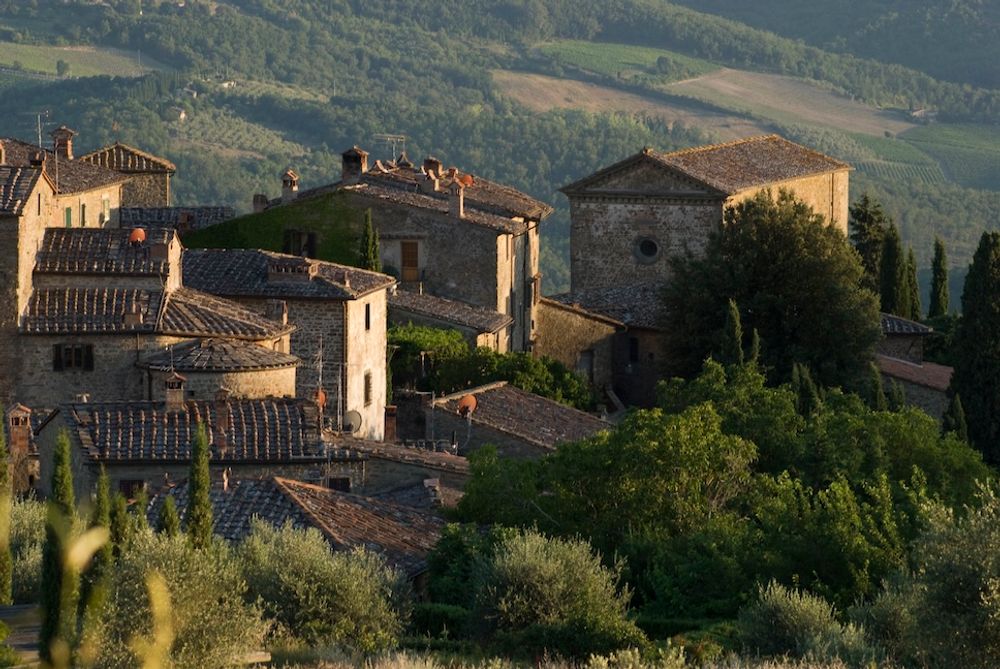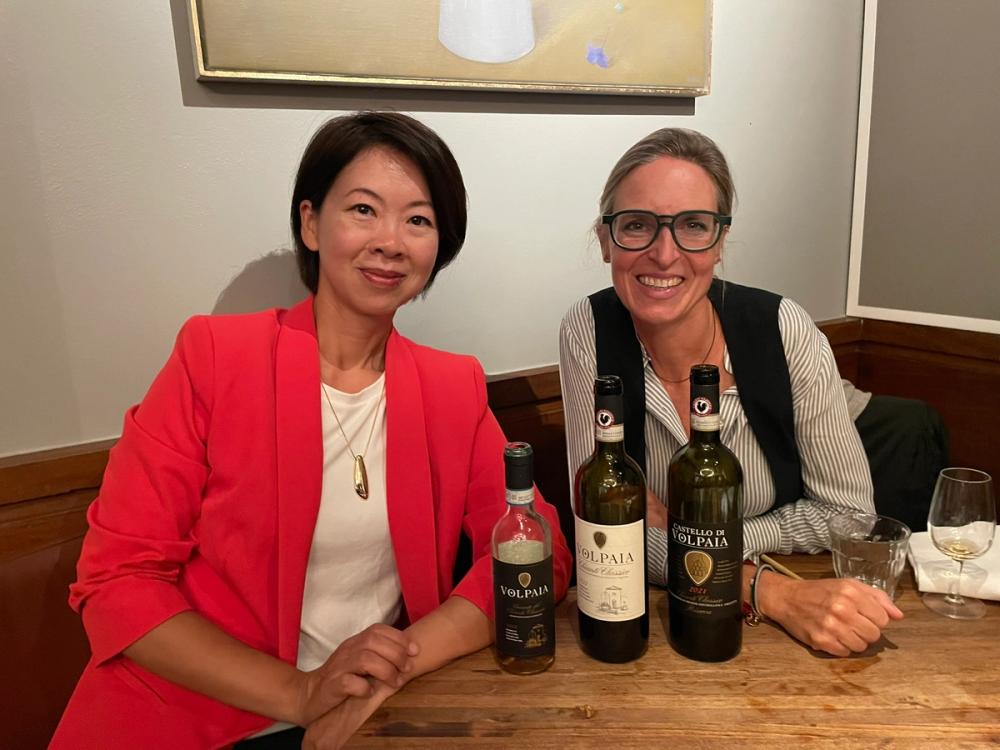Volpaia translates to “fox’s den” in Italian, so it felt rather fitting to be tasting its wines, presented by Federica Mascheroni Stianti herself, at the ever-bustling and effortlessly charming Italian restaurant Bocca di Lupo (meaning “mouth of the wolf”) in central London. Mascheroni Stianti had travelled from her family’s wine estate, Castello di Volpaia in Chianti Classico, on the very day their 2024 harvest began, to mark the launch of their new partnership with UK importer New Generation Wines.

Bought as a wedding present: Castello di Volpaia
The Mascheroni Stianti family has owned the Castello di Volpaia estate since 1966, when Federica’s grandfather bought it as a wedding gift for his daughter. What began as a hobby three generations ago has since grown into a passionate family pursuit for producing top-quality wines in the heart of Chianti Classico.
Perched nearly 600 metres above sea level, Castello di Volpaia is named after the stunning 12th-century medieval village of Volpaia in the municipality of Radda in Chianti. The village, which looks majestically grand in the photos Mascheroni Stianti showed us, is, in her words, “a very small village of 30 people, so you can easily shout from one end to the other if you don’t have a phone,” she joked.

No phones required: the stunning hamlet of Volpaia
Certified organic since 2003, Volpaia’s vineyards sit at elevations between 400 and 600 metres, much higher than the local norm.
“Due to the altitude, Radda’s wines are known for their elegance, minerality, and freshness,” Mascheroni Stianti explains. The estate’s altitude, paired with its focus on local grape varieties, sets Volpaia apart. As she put it, “Volpaia has always been a little different.”
This difference extends to the family's opposition to the DOC rules introduced in 1967, which mandated adding white grapes to Sangiovese. Like many rebellious Tuscan producers who helped spark the Super Tuscan movement, Volpaia firmly resisted.
“We realised the white grapes were doing no good to the wine. Sangiovese is a great variety and shouldn’t be ‘diluted’ with white grapes,” Mascheroni Stianti remarked. Instead, they embraced Mammolo, a local variety long planted at Volpaia, which they believe enhances and "stimulates" Sangiovese.
This philosophy gave rise to their flagship wine, Coltassala – a field blend of 95% Sangiovese and 5% Mammolo, aged for 24 months in new French oak. Tasting the 2020 vintage revealed the charm of Mammolo (appropriately named after the violet flower), which imparts a delicate floral note, balanced by blackberry and cherry, leading to an elegant, well-structured tannic profile and refreshing acidity (£45.77 ex-VAT).

Federica Mascheroni Stianti and Leona de Pasquale (r-l)
Time has proven Volpaia right. In 1996, the use of 100% Sangiovese was finally permitted and, by the 2006 vintage, the addition of white grapes was officially banned by the Chianti Classico Consortium. Interestingly, Coltassala began its journey in 1980 as a humble Vino da Tavola (table wine), later upgraded to Chianti Classico, and now bears the prestigious Chianti Classico Gran Selezione DOCG label—a testament to how far the region has evolved. “Even though it’s still the same wine,” Mascheroni Stianti wryly noted.
Volpaia followed up with another Super Tuscan in 1985, Balifico, a blend of 65% Sangiovese and 35% Cabernet Sauvignon, aged for 18 months in new French oak. The 2022 vintage boasts a deeper hue with charming notes of blackberry, red cherry, and oaky spice, underpinned by a well-defined tannic structure (£48.95 ex-VAT).
As a certified organic producer for over two decades, Volpaia places a strong emphasis on biodiversity. In the face of climate change, Mascheroni Stianti shared how the surrounding woodlands and forests have fortunately shielded their vines, offering some protection from the increasing effects of global warming.
In recent years, Volpaia has focused on preserving original Sangiovese clones. "In the past, farmers were often given land for vegetable gardens and their own vines," she explained.
One such farmer passed down knowledge of his best old Sangiovese vines before he died. From this small vineyard of over 60-year-old vines, Volpaia identified 25 different Sangiovese clones, leading to the creation of the Casanova vineyard Il Puro project. These clones are now cultivated in the estate's "Volpaia Sangiovese Library," with three to five showing exceptional promise.

The first vintage was released in 2006, and the current 2020 Casanova Il Puro Chianti Classico Gran Selezione DOCG is a 100% Sangiovese sourced from all 25 clones within a small 0.5-hectare vineyard. This wine showcases delicate sour cherry notes and refreshing acidity, complemented by an elegant structure and hints of spice from 18 months in new French oak (£82.60 ex-VAT).
While all three of Volpaia’s flagship wines are outstanding, it is the Chianti Classico 2022 and Chianti Classico Riserva 2021 that offer the best value. The 2022 vintage was a challenging year – warm, stormy, and stressful – resulting in a small addition of Merlot to round out the blend. This wine is approachable and charming, with chalky tannins and fresh red cherry notes (£17.79 ex-VAT).
The Chianti Classico Riserva 2021 was the real standout. A less extreme vintage compared to 2022, this 100% Sangiovese wine, aged for 24 months in oak, shows beautifully ripe cherry notes layered with warm spices, and its silky tannins lend a refined, well-balanced structure (£27.48 ex-VAT).
From the tasting, it is evident that Volpaia’s wines are not the big, bold, crowd-pleasing type. Instead, they offer a distinctive blend of drinkability, understated elegance, and gastronomic appeal. As Mascheroni Stianti recalled at the end of the session, her parents once hosted an informal tasting with the late Robert Mondavi. After sampling Volpaia’s wines, Mondavi remarked, “These are fantastic wines, my wines are too perfect!” The Mascheroni Stianti family have since taken this as a compliment—proof that their wines have personality, character, and a refusal to conform to convention.
The wines of Castello di Volpaia are imported and sold in the UK through New Generation Wines which is a commercial partner of The Buyer.
































